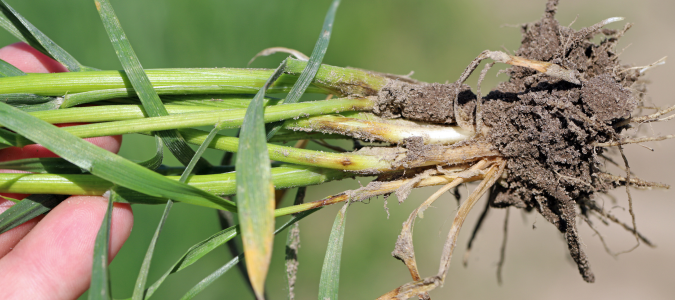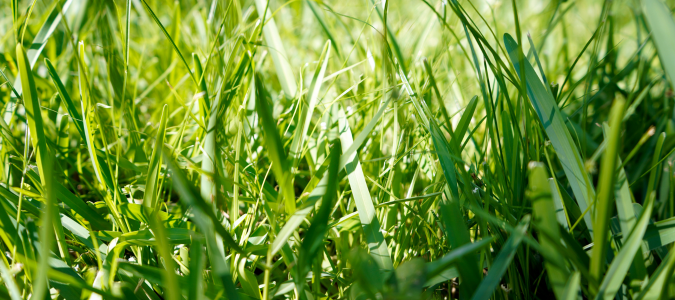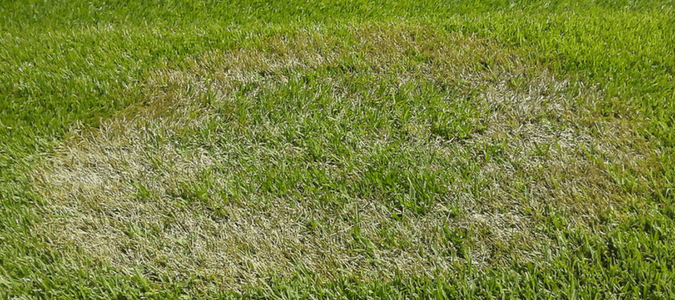For many homeowners, their lawn is their pride and joy, and they take pride in keeping it healthy and beautiful. But even with your undivided care and attention, your lawn can suffer from fungal diseases and develop unsightly brown patches. Take-all root rot is a turfgrass fungal disease that can leave your green lawn looking unsightly.
If you don’t know what take-all root rot looks like, here are the signs to look out for. If the symptoms are already widespread on your turf, it’s time to contact an expert. A lawn service professional has the tools and expertise to restore your turf to its former glory.
Appearance and Causes of Take-All Root Rot
Take-all root rot is a fungal disease that causes turfgrass to weaken, resulting in brown, irregular patches on your lawn. The fungus Gaeumannomyces graminis is the culprit behind this destructive disease. It lives in thatch, an undigested layer of leaves, roots, stolons and organic plant matter between the turfgrass and soil. Stolons are horizontal branches of a plant.
While it can produce spores, this fungus spreads primarily through stolons and roots. You don’t have to worry about spreading it when you walk on your turf or mow the grass. The disease is more likely to spread when you transfer infected grass or thatch to another area on your lawn. Take-all root rot is most common in the spring to early summer when turfgrass emerges from dormancy. It most often affects bermuda grass and St. Augustine grass.
However, it can also creep up on your lawn during other seasons since it’s a stress-activated fungal disease. The following stressors can trigger it:
- Heat or drought
- Excessive rainfall or irrigation
- Soil compaction
- Excessive shade
- Poor drainage
- Incorrect mowing height
- Excessive buildup of thatch
- Incorrect use of fertilizer or excessive herbicides
- Soil pH of more than 6.5
Signs of Take-All Root Rot
The first and most noticeable sign of take-all root is if your grass is yellowing and thinning. Eventually, the foliage will turn brown, wilt and die, leaving irregular brown patches on your lawn. These patches can be as large as 20 feet, which can be distressing to homeowners. But the real damage is underneath the soil at the roots. Diseased roots become dark, short and brittle, and the root systems thin out over time.
The turfgrass’s stolons will also suffer and become very easy to pull. Call a pro if you notice signs and symptoms of take-all root rot because this fungal disease is hard to control once it has spread.
After a pro restores your turfgrass, you can maintain it through proper lawn care practices. Try irrigating early in the morning and watering as infrequently as possible without causing drought stress. It also helps to aerate your lawn regularly to enhance the soil’s internal drainage. As your turfgrass recovers, increase your mowing height to encourage root growth. In addition, dethatching can help your turfgrass thrive. Too much thatch hampers growth and creates a home for pathogens. A lawn care professional can help you with these tasks.
Take-All Root Rot in St. Augustine Grass
Many homeowners choose St. Augustine grass for their lawns because of its beautiful, dense blue-green foliage. It also adapts well to most climates and soils and establishes itself quickly. But as with any turfgrass, it has drawbacks. St. Augustine grass is susceptible to take-all root rot, a fungal disease that causes ugly brown patches on your lawn.
The first above-ground symptom of take-all root rot on St. Augustine grass is chlorosis. You can tell this is happening if you notice irregular yellow or light green patches ranging from a couple of inches to several feet. While you can’t see it, the roots and stolons under the soil are also suffering. The roots will grow thin and turn off-white, eventually becoming black, short and rotted. As for the stolons, they may develop black lesions if the disease is severe.
St. Augustine grass usually falls victim to take-all root rot in the spring or early summer. However, it can happen at any time during the growing season. Failing to control this fungal disease will result in dead grass and brown or bare patches on your lawn. Contact a lawn care specialist if you suspect your St. Augustine grass has take-all root rot. It can be helpful to know the difference between take-all root rot and other conditions, like large patch or a chinch bug infestation. Here’s how to tell them apart.
Take-All Root Rot Versus Large Patch
Large patch is a common fungal disease among warm-season turfgrass, including St. Augustine grass. The fungus Rhizoctonia solani is responsible for large patch, and usually appears in the fall and continues into early spring. However, only certain conditions trigger the fungal disease. It’s usually more severe in over-fertilized and poorly drained turfgrass.
While take-all root rot and large patch look similar at first glance, there are notable differences between the two fungal diseases. Take-all root rot creates irregular brown patches, whereas lawns with large patch develop circular discolored patches. Another way to diagnose large patch is to see if the grass shoots pull easily from the sheath that attaches them to the stolons. In addition, infected grass shoots usually have a dark brown, slimy lesion at the base if your lawn has large patch.
Take-All Root Rot Versus Chinch Bug Infestation
Chinch bugs are not fun to have on your lawn. They live in strands of turfgrass and get their nutrition from various grasses, including St. Augustine grass. They are among the most destructive lawn pests, damaging lawns during warm and dry seasons. These bugs are as small as a sesame seed and move around quickly, making them hard to spot if you don’t know what to look for.
In addition, chinch bug injury occurs in irregular yellow patches that eventually turn brown, making distinguishing it from take-all root rot challenging. If you suspect chinch bugs are wreaking havoc on your lawn, here’s a simple hack that can confirm their presence.
Dilute one or two tablespoons of liquid dishwashing detergent in a gallon of water and pour the mixture evenly on an affected area of your lawn. Get close to the grass and check for scurrying chinch bugs. Adults are black with eye-catching shiny white wings, while nymphs are smaller and reddish with a white stripe on their back.
Take-All Root Rot Versus Brown Patch
Maintaining turfgrass can be challenging, which is why it can be heartbreaking for a homeowner to see brown patches on their lawn. Unfortunately, many factors can cause brown patches to appear out of nowhere, including take-all root rot and brown patch disease.
Determining the cause of the brown patches on your lawn will help you take the proper measures to restore your turfgrass. However, it’s not always easy to distinguish between take-all root rot and brown patch, pictured above, because they have similar symptoms. To help you, here are some ways to tell these diseases apart.
Season
Take-all root rot usually produces symptoms in spring and early summer as your turfgrass is coming out of its winter dormancy. As for brown patches, these commonly appear in the fall.
Appearance
Brown patch disease usually manifests as circular patterns. It’s more likely to appear on nights when temperatures are below 70 degrees Fahrenheit, and the soil has high moisture levels. Meanwhile, take-all root rot affects higher surface areas and shows itself as irregular patches.
Damage
While take-all root rot and brown patch disease can cause damage, take-all root rot poses a much higher threat to your lawn. Brown patch disease rarely kills the grass in infected areas. It generally only attacks the leaf shoots and stolons. The roots will usually remain alive, capable of producing new blades over time.
Unfortunately, that’s not the case with take-all root rot. It will attack the roots first, causing them to thin and rot. Because the grass shoots no longer have a way to take in water and nutrients, they will eventually wither and die. Take-all root rot is more difficult to spot than brown patch disease because the roots take the hit first, not the grass blades.
Whether you’re dealing with take-all root rot or brown patch disease, let lawn care specialists save the day. They will identify the disease and treat it to restore your lawn to its green, healthy state. You can also schedule regular maintenance checks with them to ensure your turfgrass is in tip-top shape.
Call the Pros for Your Turfgrass Troubles
Anyone who loves their lawn knows that heart-sinking feeling of seeing brown patches on their grass. Remember that lawn care professionals will know what to do. Whether it’s a fungal disease or a pest infestation behind the brown patches, they will provide the most effective treatment and give your lawn the necessary care to be healthy again.
ABC Can Keep Your Lawn Healthy and Green
The best way to prevent any problem with your lawn is to create a lawn care schedule that works best for the lawn type, soil type and sun exposure you have in your yard. Instead of spending your free time trying to determine what will work best for your particular situation, contact ABC Home & Commercial Services. Our lawn care specialists are highly-trained and can provide you with routine lawn care that keeps your lawn free of fungi, pests and other diseases.



